#pandemic wear
Explore tagged Tumblr posts
Text
CDC voice: "I know I said we'd do something about covid if it got very high again, but we have real tough jobs to do, like removing the recommendations that children with head lice or watery diarrhea be sent home to prevent further spread of their illness."
#mask up#pandemic#covid#covid 19#wear a mask#coronavirus#sars cov 2#still coviding#public health#wear a respirator
18K notes
·
View notes
Text
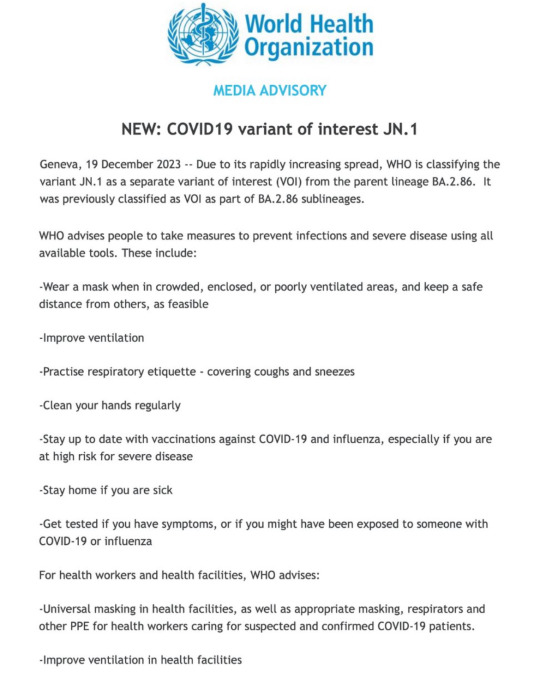
World Health Organization
MEDIA ADVISORY
NEW: COVID19 variant of interest JN.1
Geneva, 19 December 2023 -- Due to its rapidly increasing spread, WHO is classifying the variant JN.1 as a separate variant of interest (VOl) from the parent lineage BA.2.86. It was previously classified as VOl as part of BA.2.86 sublineages.
WHO advises people to take measures to prevent infections and severe disease using all available tools. These include:
-Wear a mask when in crowded, enclosed, or poorly ventilated areas, and keep a safe distance from others, as feasible
-Improve ventilation
-Practise respiratory etiquette - covering coughs and sneezes
-Clean your hands regularly
-Stay up to date with vaccinations against COVID-19 and influenza, especially if you are at high risk for severe disease
-Stay home if you are sick
-Get tested if you have symptoms, or if you might have been exposed to someone with COVID-19 or influenza
For health workers and health facilities, WHO advises:
-Universal masking in health facilities, as well as appropriate masking, respirators and other PPE for health workers caring for suspected and confirmed COVID-19 patients.
-Improve ventilation in health facilities
Image also has alt text embedded.
#WHO#health advisory#December 2023#pandemic is not over#covid#rsv#flu#please wear a mask#wear a mask#long covid#masks#ppe#n95 masks
16K notes
·
View notes
Text


save these (or download them here) to use for posters, social media, zines… whatever u want! it’s never too late to start wearing a mask again :-)
#mask up#covid19#covid isn't over#procreate#illustration#artists on tumblr#still coviding#covid cautious#face mask#queer artist#pandemic#wear a mask
22K notes
·
View notes
Text
He should NOT be at the club! There’s an airborne pandemic still killing thousands and disabling millions weekly
#this is supposed to be funny but it’s also true#covid#covid 19#covid isn’t over#pandemic#please wear a mask#wear a mask#wear a fucking mask#still masking#still coviding#he should be at the club#my post#original post#hall of fame#1k notes#2k notes#3k notes#4K notes#this is actually my first original post to get over 1000 notes (I’m not counting the comp of Louie Zong vids or the Rodney Reed petition)
4K notes
·
View notes
Text
The problem with "you can choose to wear a mask or not," is that masks mostly protect other people. So if you choose not to mask, you're actually removing someone's ability to try to protect themselves.
We know that if you wear a mask it does protect you, but only marginally. In the end, it's everyone wearing masks that prevents the spread of covid from one person to another. This is because if you have covid the mask catches the viral particles you are exhaling before they can get into the air, where covid is airborne and hangs in the air like smoke for several hours.
People who are masking are mostly protecting you. If you're in the presence of someone wearing a mask, it's literally common courteousy to do the same.
#wear a mask#covid#not wearing a mask is eugenics#covid is airborne#the pandemic isn't over just because you're over it#disability rights#human rights#disability month#spoonie
8K notes
·
View notes
Text
Did y'all know the source of the "if you don't use your immune system it gets weaker" factoid people throw around in regards to anti-masking/antivaxx/anti-public health isn't from a study or a book or even a medical professional? It's from one of George Carlin's HBO standup specials.
#covid is airborne#covid is still a thing#covid isn't over#covid 19#sars cov 2#covid#still coviding#covid19#pandemic#mask up#wear a mask#immune system#dogma
704 notes
·
View notes
Text
COVID IS NOT JUST A FUCKING COLD. IT'S NOT A COLD.
getting COVID multiple times does NOT decrease your risk of serious complications.
COVID is SERIOUS ILLNESS that can KILL you, even IF you're perfectly healthy beforehand.
you CANNOT rule out whether serious complications will happen to your our others.
if you're sick MASK UP, and STAY HOME whenever possible.
#ifairy#covid#covid 19#long covid#covid isn't over#covid pandemic#covid19#mask up#wear a mask#caps tw
2K notes
·
View notes
Text
It's still not just a cold.
"This study showing that severe acute respiratory syndrome coronavirus directly infects coronary artery plaques, producing inflammatory substances, really joins the dots and helps our understanding on why we're seeing so much heart disease in COVID patients," Peter Hotez, MD, professor of molecular virology and microbiology at Baylor College of Medicine in Houston, told Medscape.
Oh, also?
CDC predicts respiratory disease season will be similar to last year
"The CDC said it expects a similar number of respiratory disease cases this year as last year, with 15 to 25 new weekly hospitalizations per 100,000 people."
"As of Friday, nearly 12 million people have gotten the new Covid-19 vaccine since they were authorized last month, according to HHS. That’s millions more than the week prior, but still less than 4% of the US population."
No one is protecting themselves. And no one else will protect you.
Even if you're not worried for yourself....don't be one of the people that carries it to someone else. We're all responsible for the most vulnerable people in our society. (That could be you, by the way.....)
WEAR. YOUR. MASK.
2K notes
·
View notes
Text

#covid#mask up#pandemic#covid 19#wear a mask#coronavirus#sars cov 2#public health#still coviding#wear a respirator
10K notes
·
View notes
Text

Cat in the Hat:
"The German Health Minister gave an important update on the Covid situation yesterday.
I’ve written up the section of his speech from the video below for easy reading.
It’s immensely refreshing to see a government minister warning of the harms of Covid in such a transparent way."
https://x.com/_catinthehat/status/1732092683508678954

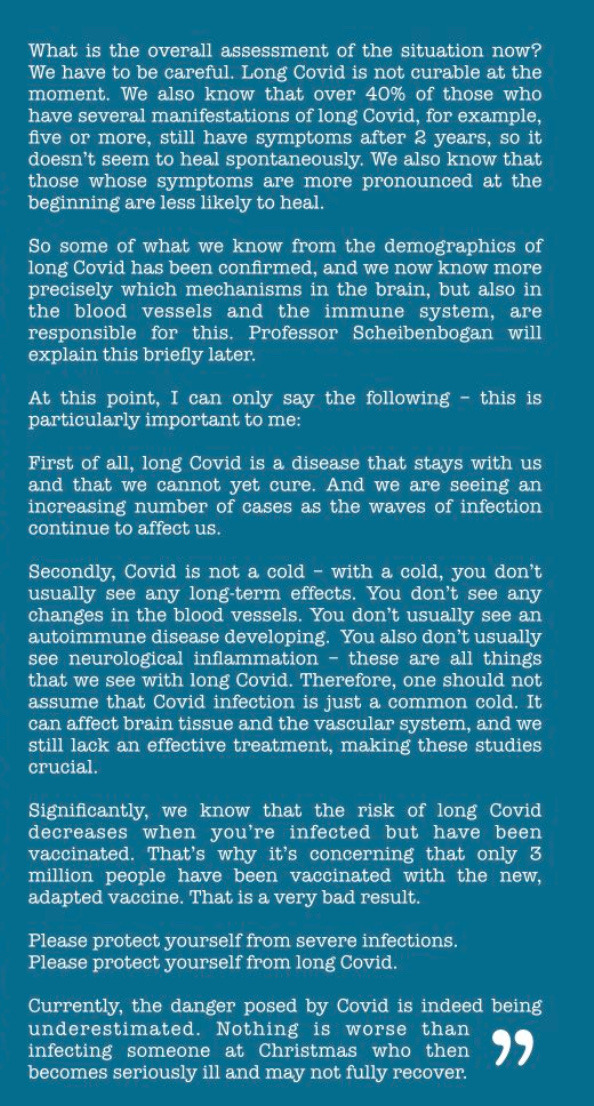
Prof. Karl Lauterbach
Health Minister, Germany
4 December 2023
"This second (long Covid) round table was very interesting, lasting three and a half hours. It serves as a unique forum for dialogue among scientists, researchers and those affected by long Covid, facilitating the exchange of ideas.
There are many new findings about long Covid. Not all of them are good news. One piece of not-so-good news concerns the fact that long Covid is actually still a problem for those who are newly infected. One estimate that has been put forward is that the risk of contracting long Covid now, even after vaccination, is around 3%. Now you may say, "that's not such a big risk" , but there are tens of thousands of people who are repeatedly affected in a short period of time. And so, the long Covid problem has not yet been solved.
We have also established that there really are many subgroups of long Covid and that we do not yet have a cure. And it was clearly pointed out that we are also dealing with problems here that will challenge society as a whole, because vascular diseases often occur after long Covid. Throughout Europe, we are currently seeing an increased incidence of cardiovascular disease in the middle-age group - from 25 to 50. This is associated with the consequences of Covid infections.
We also very often find cognitive impairment in older people. And one participant pointed out that it may well be like the Spanish flu, where 20 years after the Spanish flu there was a significant increase in Parkinson's disease and probably also dementia.
This is something we must pay attention to, as the past infection afiects how the immune system in the brain functions, as well as the brain's blood vessels, potentially increasing the long-term risk of these major neurodegenerative diseases. This is why we need to conduct very intensive research. This research has played a major role.
What is the overall assessment of the situation now?
We have to be careful. Long Covid is not curable at the moment. We also know that over 40% of those who have several manifestations of long Covid, for example, five or more, still have symptoms after 2 years, so it doesn't seem to heal spontaneously. We also know that those whose symptoms are more pronounced at the beginning are less likely to heal.
So some of what we know from the demographics of long Covid has been confirmed, and we now know more precisely which mechanisms in the brain, but also in the blood vessels and the immune system, are responsible for this. Professor Scheibenbogan will explain this briefly later.
At this point, I can only say the following - this is particularly important to me:
First of all, long Covid is a disease that stays with us and that we cannot yet cure. And we are seeing an increasing number of cases as the waves of infection continue to affect us.
Secondly, Covid is not a cold - with a cold, you don't usually see any long-term effects. You don't see any changes in the blood vessels. You don't usually see an autoimmune disease developing. You also don't usually see neurological inflammation - these are all things that we see with long Covid. Therefore, one should not assume that Covid infection is just a common cold. It can affect brain tissue and the vascular system, and we still lack an effective treatment, making these studies crucial.
Significantly, we know that the risk of long Covid decreases when you're infected but have been vaccinated. That's why it's concerning that only 3 million people have been vaccinated with the new, adapted vaccine. That is a very bad result.
Please protect yourself from severe infections.
Please protect yourself from long Covid.
Currently, the danger posed by Covid is indeed being underestimated. Nothing is worse than infecting someone at Christmas who then becomes seriously ill and may not fully recover."
Alt text is included in all images of this post.
#covid#not a cold#please wear a mask#pandemic#pandemic not over#long covid#Karl Lauterbach#Germany#German health minister
10K notes
·
View notes
Text


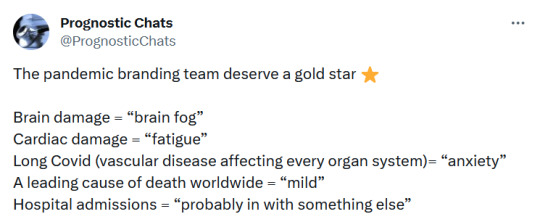





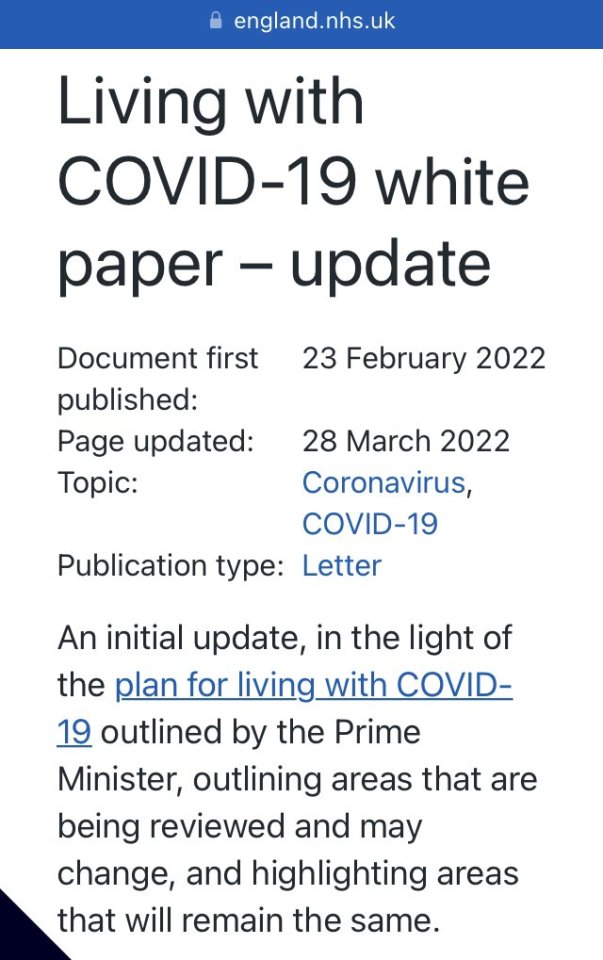
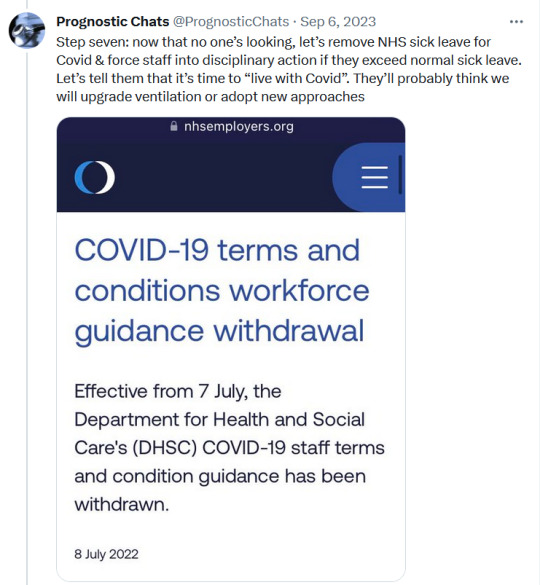


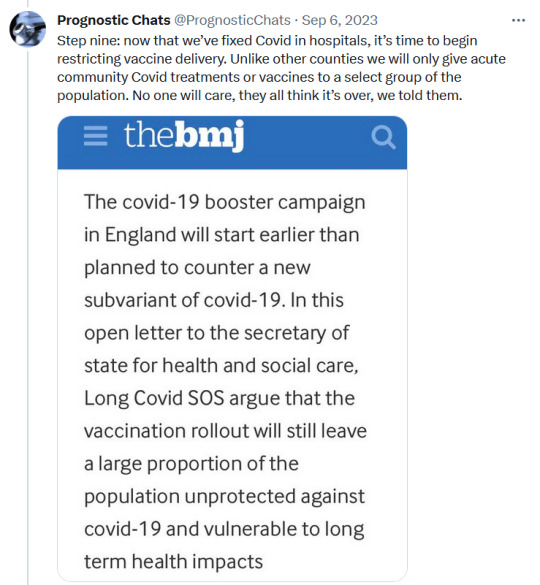
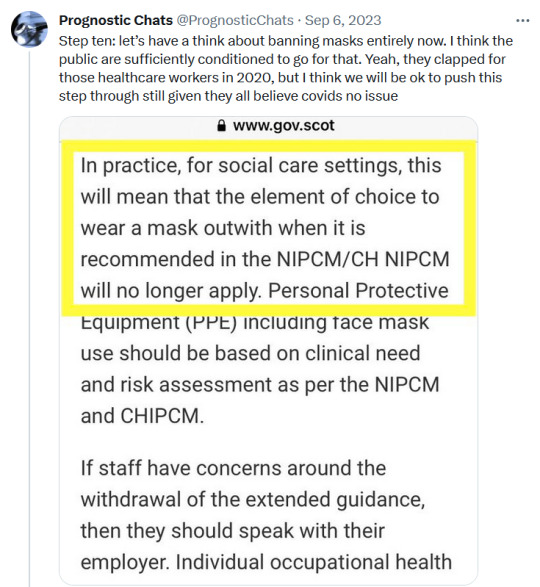
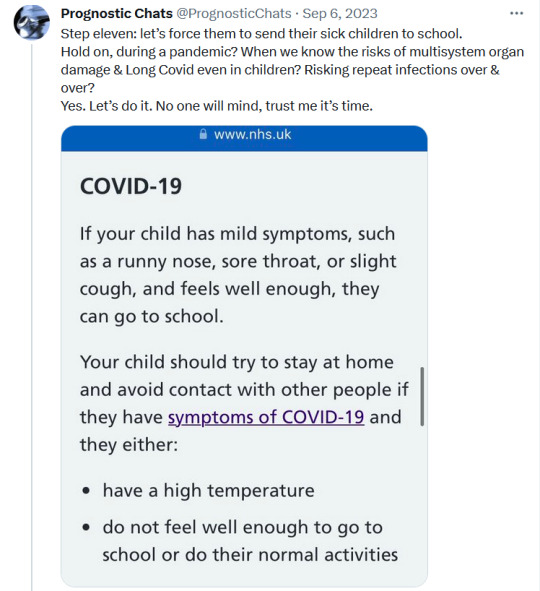

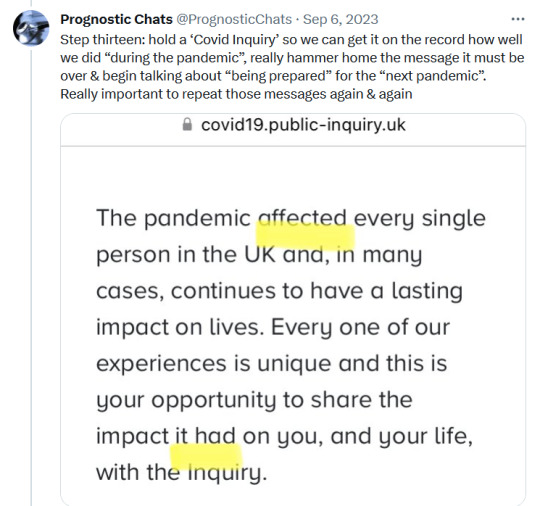


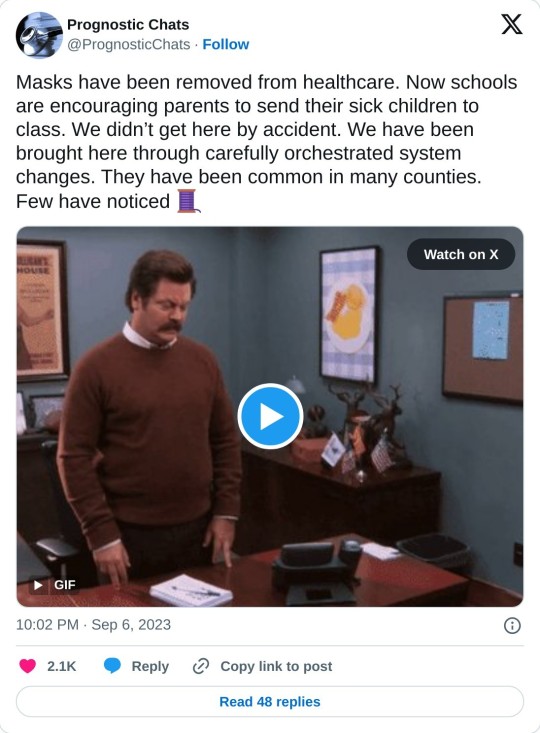
#sars cov 2#covid isnt over#pandemic isnt over#wear a mask#wear a fucking mask#alt text covid#world issues#disability rights#disability justice#important#nonfiction
1K notes
·
View notes
Text
You might be forgiven for thinking it’s been a very quiet few months for the Covid-19 pandemic. Besides the rollout of new boosters, the coronavirus has largely slipped out of the headlines. But the virus is on the move. Viral levels in wastewater are similar to what they were during the first two waves of the pandemic. Recent coverage of the so-called Pirola variant, which is acknowledged to have “an alarming number of mutations,” led with the headline “Yes, There’s a New Covid Variant. No, You Shouldn’t Panic.”
Even if you haven’t heard much about the new strain of the coronavirus, being told not to panic might induce déjà vu. In late 2021, as the Omicron variant was making its way to the United States, Anthony Fauci told the public that it was “nothing to panic about” and that “we should not be freaking out.” Ashish Jha, the Biden administration’s former Covid czar, also cautioned against undue alarm over Omicron BA.1, claiming that there was “absolutely no reason to panic.” This is a telling claim, given what was to follow—the six weeks of the Omicron BA.1 wave led to hundreds of thousands of deaths in a matter of weeks, a mortality event unprecedented in the history of the republic.
Indeed, experts have been offering the public advice about how to feel about Covid-19 since January 2020, when New York Times columnist Farhad Manjoo opined, “Panic will hurt us far more than it’ll help.” That same week, Zeke Emanuel—a former health adviser to the Obama administration, latterly an adviser to the Biden administration—said Americans should “stop panicking and being hysterical.… We are having a little too much [sic] histrionics about this.”
This concern about public panic has been a leitmotif of the Covid-19 pandemic, even earning itself a name (“elite panic”) among some scholars. But if there’s one thing we’ve learned, three and a half years into the current crisis, it’s that—contrary to what the movies taught us—pandemics don’t automatically spawn terror-stricken stampedes in the streets. Media and public health coverage have a strong hand in shaping public response and can—under the wrong circumstances—promote indifference, incaution, and even apathy. A very visible example of this was the sharp drop in the number of people masking after the CDC revised its guidelines in 2021, recommending that masking was not necessary for the vaccinated (from 90 percent in May to 53 percent in September).
As that example suggests, emphasizing the message “don’t panic” puts the cart before the horse unless tangible measures are being taken to prevent panic-worthy outcomes. And indeed, these repeated assurances against panic have arguably also preempted a more vigorous and urgent public health response—as well as perversely increasing public acceptance of the risks posed by coronavirus infection and the unchecked transmission of the virus. This “moral calm”—a sort of manufactured consent—impedes risk mitigation by promoting the underestimation of a threat. Soothing public messaging during disasters can often lead to an increased death toll: Tragically, false reassurance contributed to mortality in both the attacks on the World Trade Center and the sinking of the Titanic.
But at a deeper level, this emphasis on public sentiment has contributed to confusion about the meaning of the term “pandemic.” A pandemic is an epidemiological term, and the meaning is quite specific—pandemics are global and unpredictable in their trajectory; endemic diseases are local and predictable. Despite the end of the Public Health Emergency in May, Covid-19 remains a pandemic, by definition. Yet some experts and public figures have uncritically advanced the idea that if the public appears to be tired, bored, or noncompliant with public health measures, then the pandemic must be over.
But pandemics are impervious to ratings; they cannot be canceled or publicly shamed. History is replete with examples of pandemics that blazed for decades, sometimes smoldering for years before flaring up again into catastrophe. The Black Death (1346–1353 AD), the Antonine Plague (165–180 AD), and the Plague of Justinian (541–549 AD), pandemics all, lacked the quick resolution of the 1918 influenza pandemic. A pandemic cannot tell when the news cycle has moved on.
Yet this misperception—that pandemics can be ended by human fiat—has had remarkable staying power during the current crisis. In November 2021, the former Obama administration official Juliette Kayyem claimed that the pandemic response needed to be ended politically, with Americans getting “nudged into the recovery phase” by officials. It is fortunate that Kayyem’s words were not heeded—the Omicron wave arrived in the US just weeks after her article ran—but her basic premise has informed Biden’s pandemic policy ever since.
Perhaps even less responsibly, the physician Steven Phillips has called for “new courageous ‘accept exposure’ policies”—asserting that incautious behavior by Americans would be the true signal of the end of the pandemic. In an essay for Time this January, Phillips wrote: “Here’s my proposed definition: the country will not fully emerge from the Covid-19 pandemic until most people in our diverse nation accept the risk and consequences of exposure to a ubiquitous SARS-CoV-2, the virus that causes Covid-19.”
This claim—that more disease risk and contagion means the end of a disease event—runs contrary to the science. Many have claimed that widespread SARS-CoV-2 infections will lead to increasingly mild disease that poses fewer concerns for an increasingly vaccinated (or previously infected) population. In fact, more disease spread means faster evolution for SARS-CoV-2, and greater risks for public health. As we (A.C. and collaborators) and others have pointed out, rapid evolution creates the risk of novel variants with unpredictable severity. It also threatens the means that we have to prevent and treat Covid-19: monoclonal antibody treatments no longer work, Paxlovid is showing signs of viral resistance, and booster strategy is complicated by viral evolution of resistance to vaccines.
But these efforts to manage and direct public feelings are not just more magical thinking; they are specifically intended to promote a return to pre-pandemic patterns of work and consumption. This motive was articulated explicitly in a McKinsey white paper from March 2022, which put forward the invented concept of “economic endemicity”—defined as occurring when “epidemiology substantially decouples from economic activity.” The “Urgency of Normal” movement similarly used an emotional message (that an “urgent return to fully normal life and schooling” is needed to “protect” children) to advocate for the near-total abandonment of disease containment measures. But in the absence of disease control measures, a rebound of economic activity can only lead to a rebound of disease. (This outcome was predicted by a team that was led by one of the authors [A.C.] in the spring of 2021.)
A pandemic is a public health crisis, not a public relations crisis. Conflating the spread of a disease with the way people feel about responding to that spread is deeply illogical—yet a great deal of the Biden administration’s management of Covid-19 has rested on this confusion. Joe Biden amplified this mistaken perspective last September when he noted that the pandemic was “over”—and then backed that claim by stating, “If you notice, no one’s wearing masks. Everybody seems to be in pretty good shape.” The presence or absence of health behaviors reveals little about a threat to health itself, of course—and a decline in mask use has been shaped, in part, by the Biden administration’s waning support for masking.
Separately, long Covid poses an ongoing threat both at an individual and a public health level. If our increasingly relaxed attitude toward public health measures and the relatively unchecked spread of the virus continue, most people will get Covid at least once a year; one in five infections leads to long Covid. Although it’s not talked about a lot, anyone can get long Covid; vaccines reduce this risk, but only modestly. This math gets really ugly.
The situation we are in today was predictable. It was predictable that the virus would rapidly evolve to evade the immune system, that natural immunity would wane quickly and unevenly in the population, that a vaccine-only strategy would not be sufficient to control widespread Covid-19 transmission through herd immunity, and that reopening too quickly would lead to a variant-driven rebound. All of these unfortunate outcomes were predicted in peer-reviewed literature in 2020–21 by a team led by one of the authors (A.C.), even though the soothing public messaging at the time called it very differently.
As should now be very clear, we cannot manifest our way to a good outcome. Concrete interventions are required—including improvements in air quality and other measures aimed at limiting spread in public buildings, more research into vaccine boosting strategy, and investments in next-generation prophylactics and treatments. Rather than damping down panic, public health messaging needs to discuss risks honestly and focus on reducing spread. Despite messages to the contrary, our situation remains unstable, because the virus continues to evolve rapidly, and vaccines alone cannot slow this evolution.
In the early months of the pandemic, many in the media drew parallels between the public’s response to Covid-19 and the well-known “stages of grief”: denial, bargaining, anger, depression, and acceptance. The current situation with Covid-19 calls for solutions, not a grieving process that should be hustled along to the final stage of acceptance.
844 notes
·
View notes
Text

Reminder that if you are going to TwitchCon, DreamHack, PAX, or any other event, to please mask up. The virus is still out there. I know of a creator who had to quit streaming because of Long Covid.
#covid is not over#covid is still a thing#covid isn't over#covid 19#covid#covid pandemic#pandemic is not over#the pandemic isn't over#mask up#wear a mask#twitchcon#dreamhack#pax
179 notes
·
View notes
Text
I don't really know how to get this out there, but ideally I want as many answers as possible so if you could rb this I'd be grateful! if you want to explain your answer please feel free
#inspired by a really odd interaction I had while wearing a mask the other day#covid#covid pandemic#long covid#chronic illness#chronically ill#masking#polls
1K notes
·
View notes
Text
loving the glass onion posting but I'm really sick of the 'birdie Jay stops flirting with blanc because wearing sweatpants makes you 'fruity'' or whatever post. because:
a. bit sick of the idea that we're still perpetuating homophobic and toxic masculinity principles in this day and age, at least amongst ourselves. straight people clocking gay men for wearing a 'girly' sweatpant company feels threatening, not really like a cute queer in-joke. especially given the current climate.
b. I don't think birdie Jay WOULD stop flirting with a gay man. I bet she's the kind of woman who likes to put her hands ALL OVER her hot gay friends at the club because 'is fine you're GAY and I'm a WOMAN and it's impossible to sexually harrass a MAN right?'
c. THAT'S NOT THE REASON. she doesn't make sweatpants for her friends to wear. she makes sweatpants to profiteer off the pandemic and lockdown. blanc saying he wears sweetie pants tells her he's not a disruptor. he's not in her class. he's a MARK.
THAT is why he's off the flirting menu.
(Also this is exactly blanc's game. we know he's doing this. he's TRYING to look hokum and naive. he's trying to make them underestimate him and distract from Helen being a fish out of water too. pity this little bit worked on you too.)
#glass onion#glass onion spoilers#actually it probably also tells her that he 'lives in his' meaning he 's locking down in the pandemic#rather than partying it up with yo yo ma and wearing lace face masks#but up til then he was a famous detective and friend of Miles who was close enough to be invited on this retreat#the sweatpants line shatters that illusion#benoit blanc#birdie jay
3K notes
·
View notes
Text
So I got this idea for a "wear a mask" image, and even though it's kind of silly, once I had thought of it, I had to make it:

#X-Men#Charles Xavier#Professor X#Marvel Comics#Jack Kirby#Covid#Covid 19#pandemic#wear a mask#mask up#covid conscious#coronavirus#Wolverine is probably immune to Covid#but he might wear a mask anyway to set a good example
70 notes
·
View notes